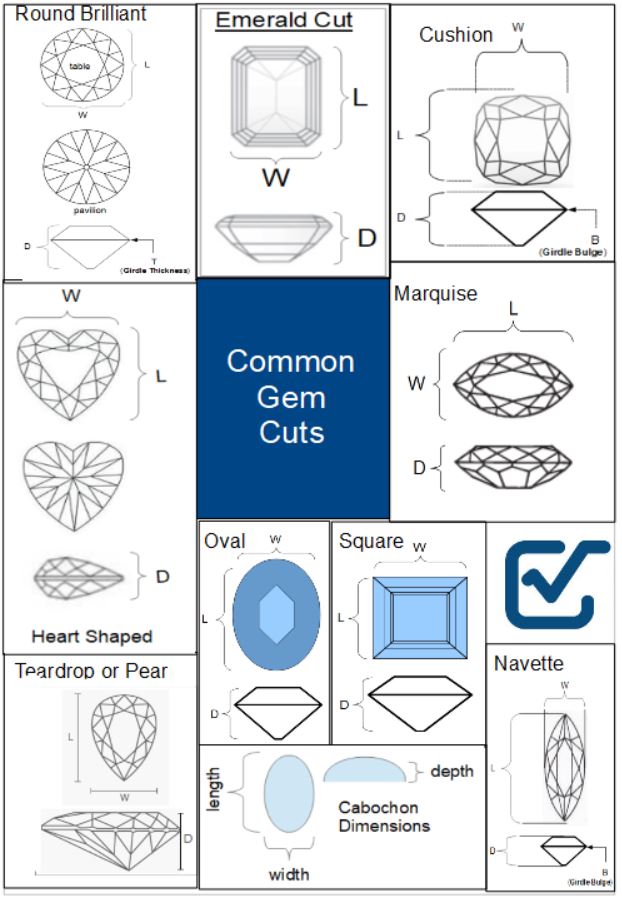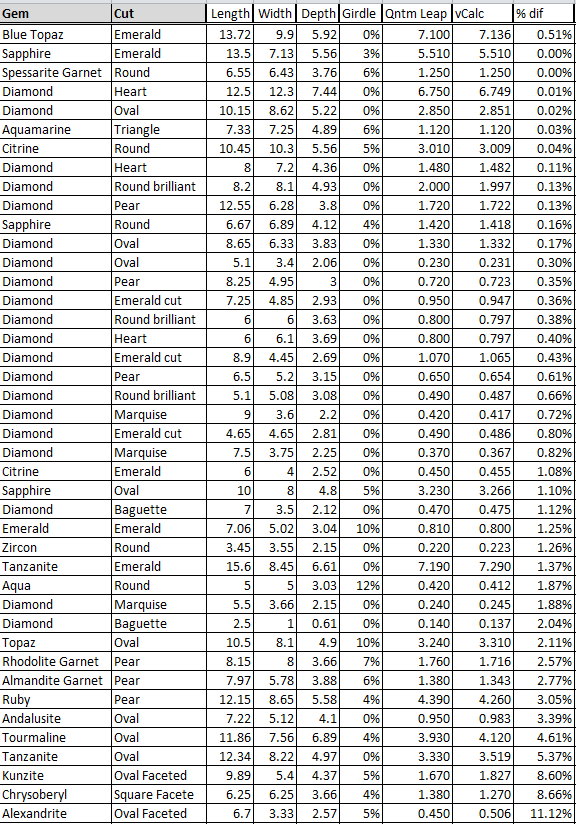Jewelers Calculator
The Jeweler's Calculator accurately calculates the carat weight of gems and the current value of precious metals including alloys of different purity. Gem weights are based on the gem type (e.g. ruby), their shapes (e.g. cabochon) and dimensions. These calculations include special functions for diamonds.
Precious Metals Calc
The Precious Metals Calculator has functions to compute the price a Jeweler can reasonably pay for items for their value in Gold, Platinum, Palladium and Silver.
| Bullion SPOT PRICES | |||
| Metal | ($/gram) | ($/troy_oz) | |
| Gold | $96.697 | $3007.61 | |
| Platinum | $29.547 | $919.01 | |
| Palladium | $28.904 | $899.01 | |
| Silver | $0.972 | $30.23 | |
| Updated every Five Minutes | |||
- Precious Metal Buy Price: Computes the Jeweler's Buy Price for several types of precious metals based on the current value of a precious metal, the metal's purity, a scrap processing fee, and the jeweler's profit margin.
- Gold Buy Price: Computes the Jeweler's Buy Price for gold based on the current value of gold, the karat purity, a scrap processing fee, and the jeweler's profit margin.
- Platinum Buy Price: Computes the Jeweler's Buy Price for platinum based on the current value of platinum, the percent purity, a scrap processing fee, and the jeweler's profit margin.
- Palladium Buy Price: Computes the Jeweler's Buy Price for palladium based on the current value of palladium, the percent purity, a scrap processing fee, and the jeweler's profit margin.
- Silver Buy Price: Computes the Jeweler's Buy Price for silver based on the current value of silver, the percent purity, a scrap processing fee, and the jeweler's profit margin.
- Junk Silver Value: Computes the current value for Junk Silver based on the dollar Face Value and the current Silver Spot Price in U.S. dollars.
- Clad Silver Value: Computes the current value for U.S. silver half dollars with dates between 1965 to 1970, based on the dollar Face Value, a Clad Silver factor and the current Silver Spot Price.
- Karat to Percentage: Convert a karat value (10, 14, 18, 22, 24) to a percent purity.
Gemstone Carat Weight Calculator:
 Weight Estimate of a Round Faceted Gem
Weight Estimate of a Round Faceted Gem- Weight Estimate of a Pear shaped or Teardrop Gem
- Weight Estimate of a Cabochon Cut Gem
- Weight Estimate of a Cushion Faceted Gem
- Weight Estimate of a Heart Shaped Gem
- Weight Estimate of an Emerald Cut Faceted Gem
- Weight Estimate of a Navette Cut Gem
- Weight Estimate of Long Rectangular Cut Gem
- Weight Estimate of Square Cut Faceted Gem
- Weight Estimate of Marquise Faceted Gem
- Weight Estimate of an Oval Faceted Gem
- Weight Estimate of Lozenge Faceted Cut Gem
Types of Gems
The gems supported in gemstone carat weight calculator include the following:
Agate, Alexandrite, Almandite garnet, Amethyst, Andalusite, Aquamarine, Aventurine, Beryl, Bloodstone, Blue Topaz, Carnelian, Cats eye, Chalcedony, Chrysoberyl, Citrine, Corundum, Demantoid Garnet, Diamond, Emerald, Golden beryl, Green beryl, Jadeite, Kunzite, Lapis Lazuli, Morganite, Nephrite Jade, Onyx, Opal, Precious topaz, Pyrope garnet, Quartz, Rhodolite garnet, Rose Quartz, Ruby, Sapphire, Sardonyx, Smokey quartz, Spessartite garnet, Spinel, Tanzanite, Topaz, Tourmaline, Tsavorite garnet, Turquoise, Yellow topaz, Zircon
Diamond Carat Weight Calculator
This jewelers suite of calculators includes carat weight estimations of diamonds based on the cut diamonds shape and size that can be measured while still within a setting. This enables the jeweler to estimate the carat weigh of the diamond without damaging the setting.
The diamond weight formulas contain carat weight equations that are specific to diamonds and diamond cuts:
- Compute carat weight of Round Brilliant diamond
- Compute carat weight of Oval Brilliant diamond
- Compute carat weight of Heart Shaped diamond
- Compute carat weight of Emerald Cut diamond
- Compute carat weight of Baguette diamond
- Compute carat weight of Princess Cut diamond
- Compute carat weight of Triangular Brilliant diamond
- Compute carat weight of Marquise Brilliant diamond
- Compute carat weight of Pear Shaped Brilliant (Teardrop) diamond
- Compute carat weight of Tapered Baguette diamond
- Compute carat weight of Old European cut diamond
- Compute carat weight of Cushion diamond
General Instructions
Precious Metal Buy Price Instructions
- The jeweler ascertains which precious metal is in the scrap (platinum, gold, palladium or silver).
- The jeweler ascertains the purity as either a karat (k) or percentage. Karat values are converted to percentages inside the Jewelers calculator automatically.
- The jeweler weighs the scrap. The Jeweler calculator accepts the most common weight units including grams and troy ounces.
- The jeweler enters the cost of refining as a percent of the transaction (e.g. 5% refinement fee)
- The jeweler enters the desired profit as a percent of the transaction (e.g. 12% profit).
- The jeweler calculator will then use these factors along with the most recent spot price for the precious metal to calculate the price the jeweler should be willing to pay for the scrap precious metal based on a spot price that is up to date within the last two minutes.
Gem Carat Estimates
The equations for diamonds and gems provide the approximate carat weight of a gem based on its shape and dimensions. These equations approximate the volume of the gem and use the specific gravity to provide a karat weight estimate. The different weight approximations are based on the shape of the gem (see list of cuts below). The vCalc library containing these equations is under Earth Science / Mineralogy / Gemology.
The gems include: Agate, Alexandrite, Almandite garnet, Amethyst, Aquamarine, Beryl, Bloodstone, Blue topaz, Carnelian, Cats eye, Chalcedony, Chrysoberyl, Citrine, Corundum, Demantoid garnet, Diamond, Emerald, Golden beryl, Green beryl, Kunzite, Lapis lazuli, Morganite, Onyx, Opal, Precious topaz, Pyrope garnet, Quartz, Rose Quartz, Ruby, Sapphire, Sardonyx, Smokey quartz, Spessartite garnet, Tanzanite (zoisite), Topaz, Tourmaline, Tsavorite garnet, Turquoise, Yellow topaz, Zircon.
The gem cuts include: round (circular), oval, emerald cut, long rectangular, square, navette or boat-shaped, pear-shaped or teardrop, cabochon, princess cut, Cushion cut, Old European cut.
Diamond Carat Estimates
The Diamond Weight tab contains carat weight equations that are specific to diamonds and diamond cuts.
NOTE: Never use an estimating equation for the weight of a gem if you can weigh it on a quality jeweler's scale. These equations are useful when the jeweler is trying to preserve the setting of the gem while still providing a carat weight estimate. In this way, the jeweler can ascertain the type of gem, its shape and then using precise measuring tools measure the salient dimensions for use in these equations. These steps can be done while the gem remains in the setting.
The vCalc Jeweler's calculator is free to use like all the other equations and calculators found in vCalc. Please feel free to comment on this wiki page using the comment button below and help us make a better Jeweler calculator for you.
APPLICATIONS
The vCalc Jeweler's Calculator provides Jewelers and other merchants of gems and precious metals to compute an estimated current market value for jewelry items. Likewise private owners and insurance providers can make similar estimates for use in establishing the basis for insurance valuation and coverage.
ACCURACY COMPARISON
The carat weight equations and data used in vCalc's jewelry library and calculator were reviewed by a certified gemologist. The equations are based on industry recognized formulas and data. The table below shows a comparison of computations between vCalc and an industry accepted application (Quantum Leap).
The length, width and depth are in millimeters (mm), and the Quantum Leap and vCalc measurements are in carats (cwt).

The largest variance, an oval faceted alexandrite, which can be seen in the last row above, has been double checked against several source equations which tend to support vCalc's accuracy.
Calculators and Collections
Equations
- Precious Metal Buy Price KurtHeckman Use Equation
- Gold Buy Price KurtHeckman Use Equation
- Platinum Buy Price KurtHeckman Use Equation
- Palladium Buy Price KurtHeckman Use Equation
- Silver Buy Price KurtHeckman Use Equation
- Junk Silver Value pro Use Equation
- Clad Silver Value KurtHeckman Use Equation
- Karat to Percentage KurtHeckman Use Equation
- Round Faceted Gem Weight KurtHeckman Use Equation
- Pear or Teardrop Gem Weight KurtHeckman Use Equation
- Cabochon Cut Gem Weight KurtHeckman Use Equation
- Cushion Faceted Gem Weight KurtHeckman Use Equation
- Heart Shape Faceted Gem Weight KurtHeckman Use Equation
- Emerald Cut Faceted Gem Weight KurtHeckman Use Equation
- Navette or Boat-shaped Gem Weight KurtHeckman Use Equation
- Long Rectangular Cut Gem Weight KurtHeckman Use Equation
- Square Cut Faceted Gem Weight KurtHeckman Use Equation
- Marquise Faceted Gem Weight KurtHeckman Use Equation
- Oval Faceted Gem Weight KurtHeckman Use Equation
- Lozenge Faceted Gem Weight KurtHeckman Use Equation
- Round Brilliant Diamond Weight KurtHeckman Use Equation
- Oval Brilliant Diamond Weight KurtHeckman Use Equation
- Heart Shaped Diamond Weight KurtHeckman Use Equation
- Emerald Cut Diamond Weight KurtHeckman Use Equation
- Baguette Cut Diamond Weight KurtHeckman Use Equation
- Princess Cut Diamond Weight KurtHeckman Use Equation
- Triangular Brilliant Diamond Weight KurtHeckman Use Equation
- Marquise Brilliant Diamond Weight KurtHeckman Use Equation
- Pear Shaped Diamond Weight KurtHeckman Use Equation
- Tapered Baguette Diamond Weight KurtHeckman Use Equation
- Old European Cut Diamond Weight KurtHeckman Use Equation
- Cushion Diamond Cut Weight KurtHeckman Use Equation
- Comments
- Attachments
- Stats
No comments |

